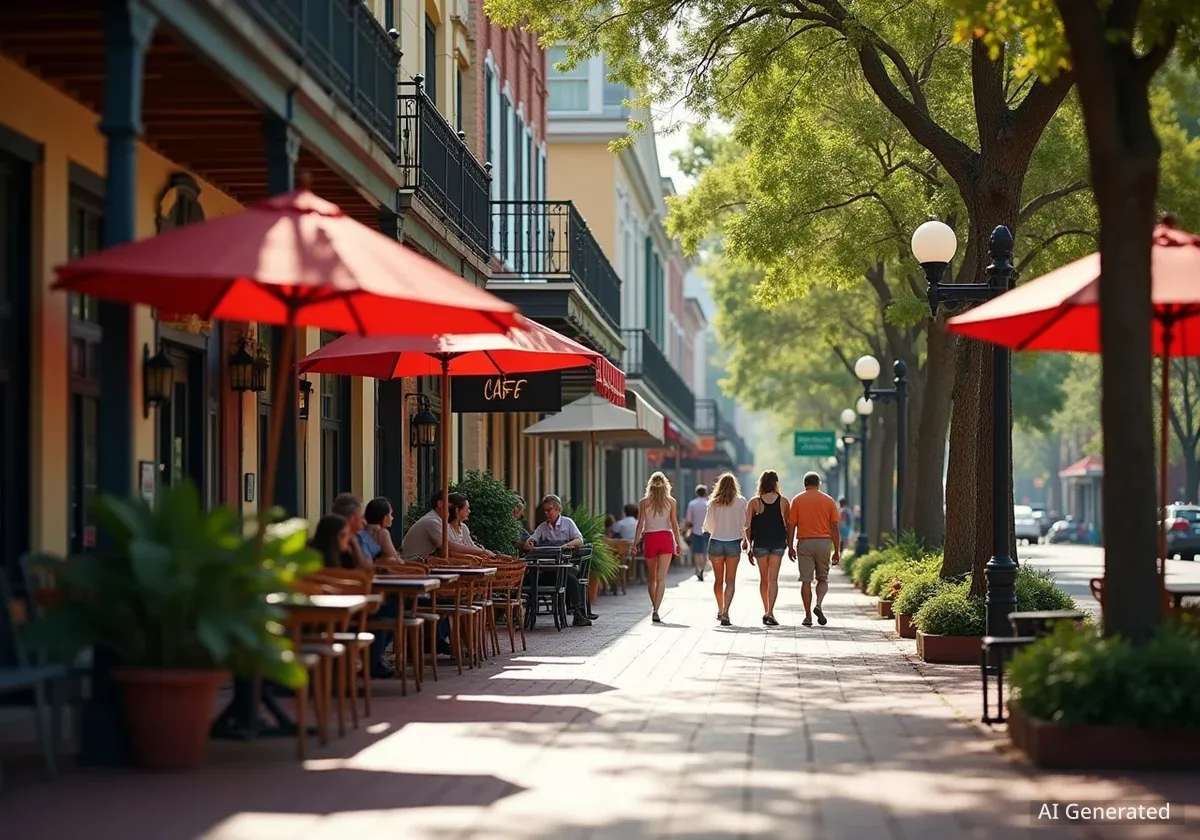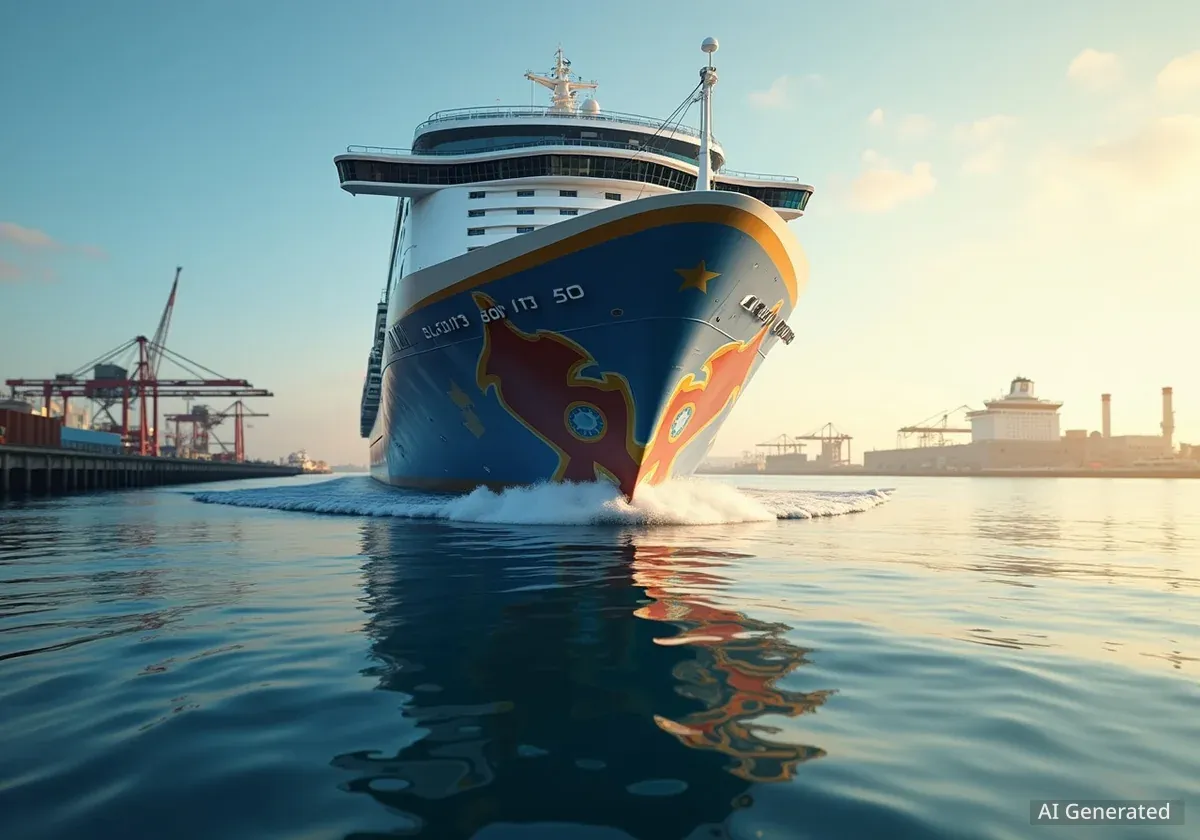Florida is known for its major attractions, but its true appeal often lies in smaller communities. These towns offer a genuine sense of welcome, characterized by local businesses, walkable streets, and traditions that invite visitors to participate. This guide focuses on places where hospitality is a natural part of daily life, not a marketing strategy.
Key Takeaways
- Twelve Florida towns offer authentic local experiences.
- Emphasis is on walkable areas and community traditions.
- These towns showcase Florida's natural warmth and identity.
Stuart: The Sailfish Capital
Stuart, often called "The Sailfish Capital of the World," has a culture deeply connected to the sea. Located between the St. Lucie River and the Atlantic Ocean, the town's rhythm is shaped by its maritime heritage. This influences waterfront events and the historic downtown area.
The town center is compact and features the 1920s Lyric Theatre. Narrow streets host family-owned shops and cafes. Stuart is notable for combining Treasure Coast history with easy walkability, especially along the Riverwalk. This wooden boardwalk often features live music and offers views of dolphins.
Quick Facts: Stuart
- Location: Between St. Lucie River and Atlantic.
- Key Feature: Historic, walkable downtown and Riverwalk.
- Notable Landmark: Lyric Theatre (1920s).
For a morning start, Gilbert's Coffee Bar provides outdoor seating with views of moored sailboats. The Gafford is a popular local choice for Southern cuisine. The Elliott Museum on Hutchinson Island displays vintage cars and baseball memorabilia. Shepard Park offers shaded benches along the St. Lucie River, where manatees are sometimes seen at sunset.
Cedar Key: An Isolated Gulf Gem
Cedar Key, one of Florida's oldest ports, is defined by its isolation. This town sits three miles into the Gulf of Mexico on a group of small islands. It offers a slower pace of life with no chain restaurants or stoplights. Most buildings are on stilts, and pelicans are a common sight.
Historically, Cedar Key exported thousands of cedar pencils daily. Today, its welcoming atmosphere comes from shrimp boats passing Dock Street and a quiet environment. This absence of urban noise is a key part of its appeal.
"Cedar Key offers a unique escape where the pace of life truly slows down, connecting visitors with Florida's historical maritime roots."
Steamers Clam Bar & Grill on Dock Street is known for its Cedar Key clam chowder and signature Clam Pot, featuring locally farmed clams. Large windows provide views of the working waterfront, highlighting the fresh, local ingredients. The Cedar Keyhole Artist Co-op, located upstairs on the boardwalk, showcases art from over 20 regional artists.
Historical Context: Cedar Key
Cedar Key's history as a major port dates back centuries. Its unique geography has preserved much of its original character, resisting modern development common in other Florida coastal areas.
On the western side of town, Cemetery Point Park has a nature trail and offers elevated views of the surrounding keys. The Cedar Key Historical Society Museum documents the town's 19th-century history with shipping logs and relics, including a preserved post office.
Apalachicola: Oyster Heritage and River Life
Apalachicola's identity is deeply linked to oysters. Even as Apalachicola Bay recovers from a decline in oyster populations, the town remains connected to the estuary. This area once produced 90% of Florida's wild oysters. While the number of seafood houses has decreased, local pride remains strong.
Boats still line the riverfront, and downtown buildings retain a faint scent of salt and brine. The town operates at a deliberate pace, where locals often know each other by name. The core of the town is walkable in about fifteen minutes, but people typically take their time.
Apalachicola's Oyster History
At its peak, Apalachicola Bay supplied 90% of Florida's wild oysters, making it a critical economic and cultural hub for the region.
Oyster City Brewing Company, housed in a former auto parts store, is a popular spot for locals and visitors, serving beers like Hooter Brown Ale. Next door, the Hole in the Wall Raw Bar focuses on Apalachicola oysters and shrimp. The Owl Café offers seafood and Southern dishes in a converted brick building with pressed tin ceilings.
The John Gorrie Museum, located near Avenue D, tells the story of the local doctor who invented mechanical refrigeration in the 1840s. Lafayette Park, near sunset, provides benches along the bay where shrimp boats pass and egrets feed in the shallows.
Dunedin: A Scottish-Influenced Gulf Coast Town
Dunedin is distinct in Florida for its strong Scottish heritage. This influence is not just for tourism; it is a living part of the community. The city hosts a Highland Games every spring, and street signs feature Gaelic names. Local bagpipers participate in parades.
This heritage blends seamlessly with the relaxed Gulf Coast lifestyle. The town's walkable downtown is located along the Pinellas Trail, a 45-mile biking path that runs through Main Street. Cyclists, retirees, and shopkeepers often mix, and most storefronts have bike racks.
Dunedin's Unique Identity
Dunedin's Scottish roots are a genuine part of its fabric, influencing everything from local events to street names, creating a cultural experience unlike other Florida towns.
At the intersection of Main and Douglas, Café Alfresco serves Gulf shrimp and grilled grouper on a busy patio. A few blocks west, Dunedin Brewery, Florida’s oldest craft brewery, hosts live music and offers classic beers like Red Head Red Ale.
For beach access, Honeymoon Island State Park is located across the causeway, offering four miles of undeveloped shoreline and trails. The Dunedin History Museum, housed in a 1924 train depot, documents the town's past, including its railroad and citrus industries. Visitors often find themselves staying longer in Dunedin.
Safety Harbor: Mineral Springs and Historic Charm
Safety Harbor's name comes from Spanish explorers who believed its natural mineral springs held healing properties, making it a "safe harbor." This belief has continued, with the springs still flowing beneath the Safety Harbor Resort and Spa, one of Florida’s oldest operating spa hotels.
The town itself is compact, faces Old Tampa Bay, and retains much of its original character. Many homes date back to the 1920s, featuring porches close to sidewalks and brick streets shaded by oak trees. This preserved architecture contributes to its unique appeal.
Safety Harbor's Healing Waters
The mineral springs in Safety Harbor were historically believed to have healing powers, a tradition that continues with its historic spa.
Café Vino Tinto is a family-run Costa Rican coffeehouse known for its in-house roasting and Latin lunch menu. A short walk away is Whimzeyland, a residential folk art house covered in bottle caps, tiles, and colorful items, created by local artists Todd and Kiaralinda.
The Safety Harbor Museum and Cultural Center, located inland, preserves Tocobaga artifacts and supports the town's cultural activities. These elements combine to give Safety Harbor a distinctive and welcoming atmosphere.
Tarpon Springs: A Greek Sponge Diving Legacy
Tarpon Springs has the highest percentage of Greek-Americans in the United States. This heritage comes from the sponge industry, which attracted Greek divers in the early 1900s. The sponge docks remain active, with boats returning daily along the Anclote River.
Greek is commonly spoken in local shops, and bouzouki music can be heard from doorways. St. Nicholas Greek Orthodox Church, with its domes and stone facade, is a prominent landmark. Its annual Epiphany Day cross dive attracts thousands of visitors.
Tarpon Springs Demographics
Tarpon Springs boasts the highest percentage of Greek-Americans of any U.S. city, a direct result of its historical sponge diving industry.
Hellas Restaurant and Bakery on Dodecanese Boulevard is a popular choice for lamb shank, saganaki, and lemon potatoes. The Tarpon Springs Sponge Exchange is now a shopping village, but it still displays items from the original trade, such as natural sponges and brass diving helmets, in shops like Spongeorama.
Upriver, Craig Park curves around Spring Bayou, where manatees appear in winter. Locals gather under large oak trees year-round. Sunset Beach offers a quiet sandy stretch with no condominiums, providing a peaceful Gulf view.
Mount Dora: Florida's Elevated Art Hub
Mount Dora is situated on Lake Dora, but its defining feature is its elevation. At 184 feet above sea level, it is one of the highest points in peninsular Florida. Early railroad passengers named it "Mount" because of its views.
The town's character is shaped by its commitment to preservation. Many downtown buildings, including Victorian homes, clapboard shops, and a 1920s railroad depot, are still in use. The streets are brick, and the lampposts are cast iron. Art festivals draw tens of thousands, yet the town's atmosphere remains consistent.
"Mount Dora offers a charming blend of historic preservation and vibrant cultural events, creating a unique inland Florida experience."
Cody's on 4th is a local favorite for coffee and cheddar scones. The Modernism Museum, nearby, features a permanent collection of functional art, including furniture by the Memphis Group. For lunch, Pisces Rising serves Gulf fish and fried green tomatoes on a deck overlooking the lake.
Mount Dora's Cultural Significance
Mount Dora is renowned for its preservation efforts and its vibrant arts scene, hosting numerous festivals that attract visitors while maintaining its small-town charm.
In the late afternoon, Gilbert Park offers boardwalk access through moss-draped trees and into the shallow waters of Lake Dora, where herons and alligators can be seen.
Fernandina Beach: Isle of Eight Flags
Fernandina Beach is unique as the only U.S. city to have flown eight different national flags. This history reflects territorial changes, smugglers, and early outlaws, earning it the nickname "Isle of 8 Flags." Today, its appeal lies in its stability.
The historic district spans 50 blocks of preserved Victorian architecture, still home to grocers, tailors, and taverns. Shrimping was central to the economy in the 20th century, and the annual Isle of Eight Flags Shrimp Festival continues to define the town's identity. The port remains active, and the downtown area is well-preserved.
Historical Record: Fernandina Beach
Fernandina Beach holds the distinction of being the only U.S. city to have been under eight different national flags throughout its history.
T-Rays Burger Station, a former gas station on 8th Street, serves blackened shrimp and hand-formed burgers. On Centre Street, the Palace Saloon, Florida’s oldest continuously operating bar, offers drinks and local stories under a pressed-tin ceiling.
The Amelia Island Museum of History, once the county jail, now features exhibits on pirates, plantations, and phosphate shipping. For ocean access, Main Beach Park provides direct entry to the Atlantic and a boardwalk popular with early risers and surfcasters.
St. Augustine: America's Oldest Continuously Inhabited City
St. Augustine is the oldest continuously inhabited European-founded city in the continental U.S. Its most notable characteristic is how centuries of history coexist. Coquina stone structures from the 1600s stand alongside 1920s Mediterranean Revival homes. The city's layout still follows the original Spanish street plan.
The Castillo de San Marcos, built in the 1670s, anchors the waterfront. Its walls show signs of cannon fire and the passage of time. This layering of architectural, cultural, and personal history shapes every part of the old town.
St. Augustine's Age
Founded in 1565, St. Augustine is the oldest continuously inhabited European-established settlement in the United States.
Crucial Coffee Café operates out of a wooden shack, offering strong iced Cuban coffee. A few blocks away, the Lightner Museum, located in the former Alcazar Hotel, displays stained glass, vintage typewriters, and items once owned by Otto Lightner.
At dusk, the lawn of the Castillo fills with people enjoying the evening as the Matanzas River reflects the city's changing light. This blend of history and daily life makes St. Augustine a unique destination.
Key West: The Conch Republic's Unique Charm
Key West is geographically closer to Havana than Miami, and its culture reflects this. The Conch Republic declared symbolic independence from the U.S. in 1982, a playful act that set a lasting mood. The island operates at its own pace.
Chickens roam freely, and Ernest Hemingway's six-toed cats are a protected population. Locals, known as Conchs, welcome visitors with stories that often blend fact and folklore. Time moves more slowly here, contributing to its relaxed atmosphere.
The Conch Republic
Key West's symbolic declaration of independence in 1982 highlights its distinct cultural identity and independent spirit, which continues to define the island.
Blue Heaven serves yellowtail snapper and banana pancakes under a tin roof and banyan trees, with roosters wandering through the dining area. Sloppy Joe’s on Duval Street, a former regular spot for Hemingway, offers live music seven days a week and remains open even during hurricanes, unless the roof is damaged.
The Key West Lighthouse and Keeper’s Quarters Museum allows visitors to climb 88 iron steps for views extending past the coral reef. At Fort Zachary Taylor Historic State Park, locals gather at the rocky beach, while snorkelers explore the jetty.
Islamorada: The Sportfishing Capital
Islamorada is a village composed of islands stretched between the Everglades and the reef line, shaped by both water and history. The 1935 Labor Day Hurricane, the most intense to hit the U.S., devastated the area. The Florida Keys Memorial commemorates over 400 victims of this event, with their names carved into coral rock.
Today, Islamorada embraces its identity as the "Sportfishing Capital of the World," but its welcoming nature extends beyond the marina. Residents are familiar with each tide, and conversations flow easily between boat slips and bait shops.
Islamorada's Fishing Legacy
Islamorada is globally recognized as the "Sportfishing Capital of the World," attracting anglers from around the globe.
The Green Turtle Inn, established in 1947, serves fish sandwiches and key lime pie in a building that once functioned as both a bus stop and a barbershop. The History of Diving Museum displays antique helmets, air pumps, and sponge-diving equipment collected over decades.
Morada Bay Beach Café offers grilled snapper and mango slaw with tables directly on the sand, perfect for sunset dining. At Founders Park, locals swim in the Olympic pool, while families relax on the shallow beach.
Anna Maria: Preserving Island Serenity
Anna Maria is located at the northern tip of Anna Maria Island, where the Gulf of Mexico meets the bay. Zoning laws prevent buildings taller than three stories. The town has resisted development, not out of nostalgia, but through community consensus.
There are no high-rises, fast-food chains, or parking meters. Residents primarily travel by foot, bike, or golf cart. Streets are named after seashells and early settlers. The wooden pier on Pine Avenue dates back to 1911 and remains a popular spot for fishermen at dawn.
"Anna Maria Island's commitment to low-rise development and local charm creates a peaceful, authentic Florida beach experience."
Ginny’s & Jane E’s, housed in a former grocery store on Gulf Drive, offers cinnamon rolls and Cuban sandwiches alongside local art and used books. Sandbar Restaurant, at the western end of Spring Avenue, allows diners to eat grouper tacos with their feet in the sand.
Anna Maria's Development Philosophy
Anna Maria's strict zoning laws and community-driven development policies have successfully preserved its low-key, historic island atmosphere, distinguishing it from many other Florida coastal areas.
The Anna Maria Island Historical Museum, located in a former icehouse, traces the island’s past through displays of net-mending benches, hurricane logs, and family photos. Bayfront Park offers a quiet beach with views of the Sunshine Skyway Bridge and picnic tables shaded by sea grapes.
These twelve towns offer an authentic Florida experience, defined by local customs, community spirit, and a genuine welcome that makes visitors feel at home. They represent a quieter, slower, and more rooted version of the state, visible in every friendly gesture.





